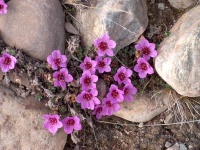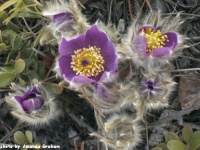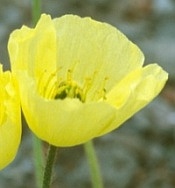How are plants able to grow in the Arctic? There are ways that plants have adapted.
Most of the plants are small, grow close together and close to the ground. This protects them from the cold temperatures and the strong winds.

purple saxifrage
click on photo for larger image

to the ground and is covered with fine hairs.
see a larger photo
Flowering plants use the long hours of sunlight to produce flowers quickly in the short growing season.
Some plants have cup-shaped flowers that face up to the sun, so the sun's rays are directed towards the centre of the flower. These plants stay warmer than the air around them.

see a larger photo
Others are dark coloured so the plants can absorb more solar heat.
Only the top layer of soil thaws out so plants have shallow roots.
Small leaves help the plants retain moisture.
Because of the short growing season, most tundra plants are perennials. Perennials do not die in the winter.
Some plants, like lichens, can survive on bare rock.
Moss can grow in wet places or on bare rock.